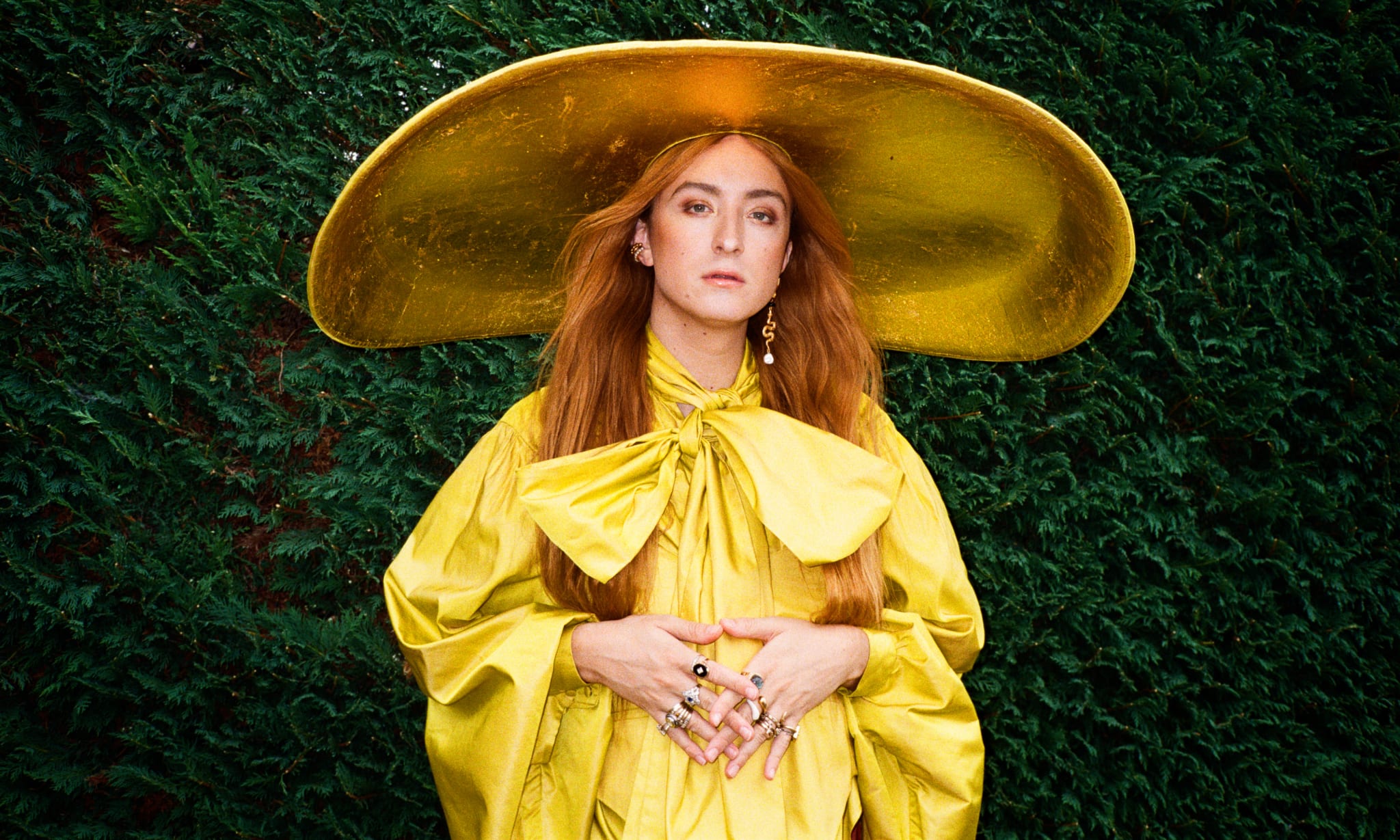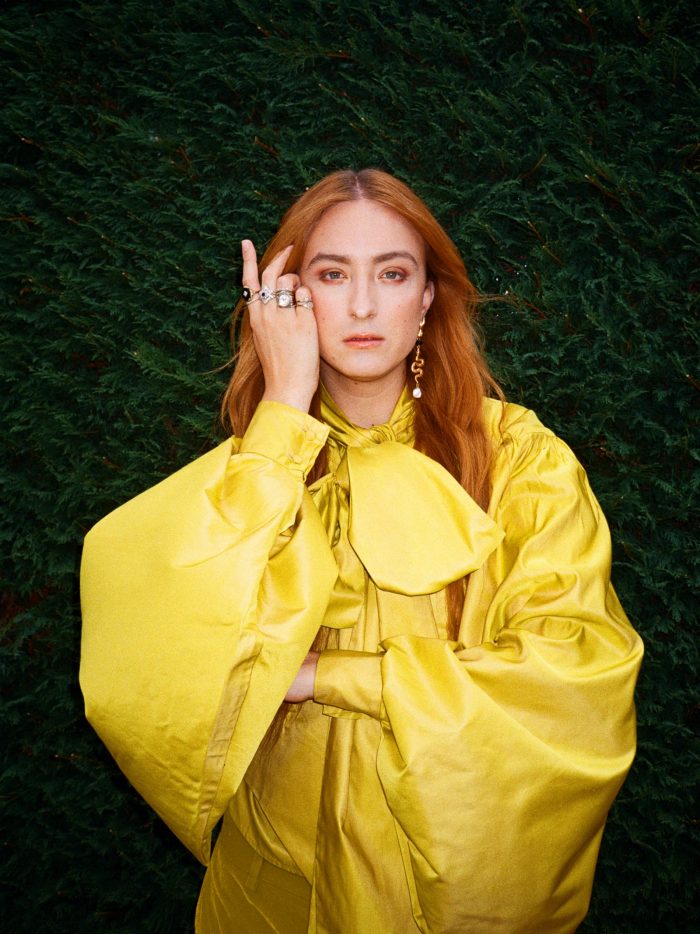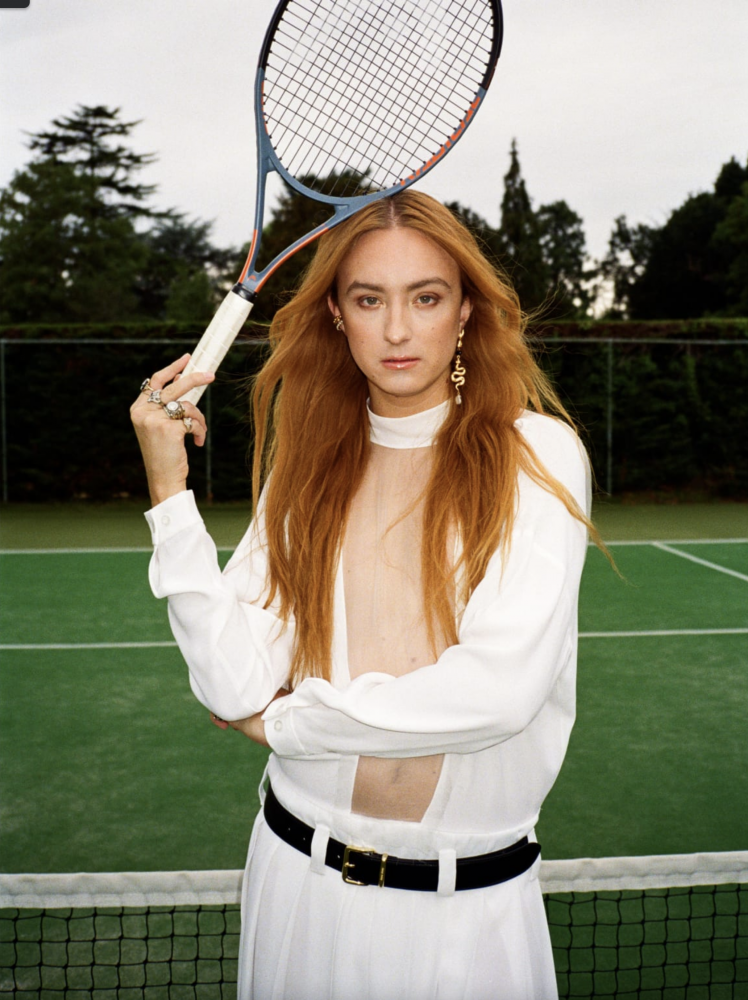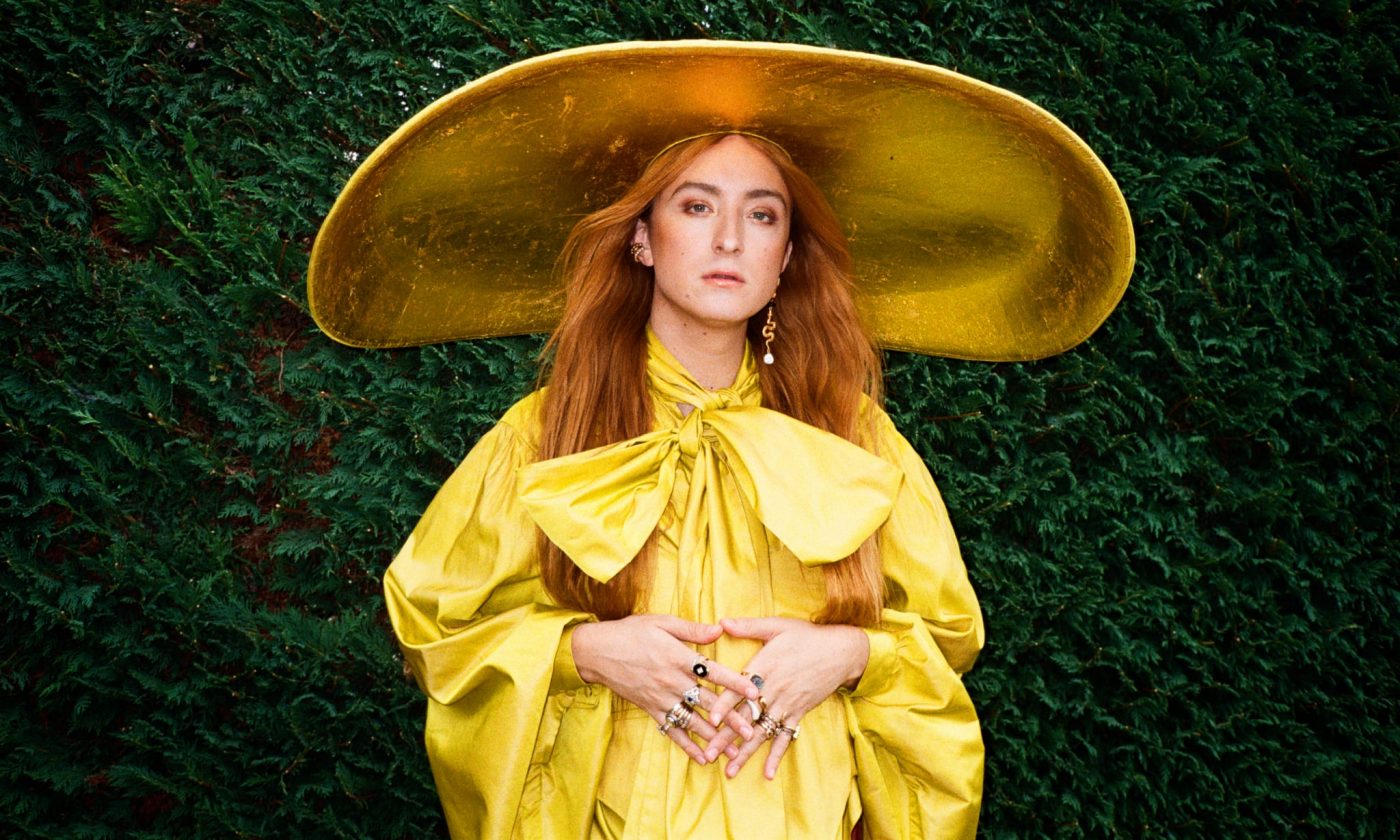Harris Reed talks fashion and fluidity
The winner of our Designer award speaks to Teo van den Broeke about pushing style in a more inclusive direction and keeping secrets with Beyoncé

Harris Reed is not your average 26-year-old. Case in point, just two weeks before we met for this interview, the designer posted a picture to his Instagram feed of the planet’s most powerful popstar on the cover of the world’s most influential fashion magazine, wearing one of his characteristically outré creations. For any other person with fewer than 10,000 days on earth under their Alaïa corset belt it would have been a pinch-me moment, but for Reed it was just another day at the office.
‘The Beyoncé [British] Vogue cover came about at the same time as I was working on Adele’s music video,’ the designer tells me in his Cali-spiked drawl, which slips out of his mouth at breakneck speed. We’re sitting in the back of a black Mercedes en route to the Soho House Awards shoot – Reed is winning our Designer category – and he is in a chatty mood, though somehow one doubts he ever isn’t. ‘Everyone knows that Adele’s biggest idol is Beyoncé and, as we were wrapping, I was thinking, How is it going to get bigger? Then Edward Enninful’s team called me and asked if I could customise a look for the cover of the July issue.’
Was he surprised to get the call? ‘I was like, “Oh. My. God. That’s incredible”,’ says Reed, fixing his dollish eyes on mine emphatically. ‘Beyoncé’s stylist Marni [Senofonte] contacted me later that week and asked me for a few more looks for some album shots. I can’t say too much, but we’ve done a few surprises with her.’ He continues: ‘One of the main reasons it’s been so amazing is because Beyoncé’s new album is all about this kind of club kid vibe, which is very in line with what I do. It was great to whip out the sequins and the crystals, and really camp it up.’
On the Vogue cover (pictured below), the ‘Break My Soul’ superstar wore an enormous Harris Reed halo headdress, not dissimilar to the one he designed for supermodel Iman to wear to the Met Gala in 2021. ‘I’ve not had any contact with Beyoncé directly since,’ Reed demures. ‘I’ve had one-word bits of feedback like, “love”, but I’ve not had the “Hey girl!”, which I think is good because some of the pieces we’re sending are really out there. I make complicated clothes, so sometimes I don’t really want to know if things aren’t fitting or whatever. There’s a lot of headdresses and different stuff involved with my work, so I’d prefer to get a “you killed it” later on, than a “f**k, it doesn’t fit” directly from Beyoncé.’


Dressing Bey was not Reed’s first moment in the international spotlight, of course. The British-American designer, who graduated from Central Saint Martins in 2020 and has since shown just five ‘demi-couture’ collections as part of London Fashion Week, first made it into the public consciousness when he kitted Harry Styles in a gown for the cover of US Vogue in December of his graduating year. Since then, Reed has appeared on the cover of Harper’s Bazaar UK wearing a dress of his own creation, enticed Sam Smith to perform at his AW22 show – which featured a statuesque boy wearing a fantastical genderless breastplate complete with Saint Sebastian-style arrows – and become a figurehead for the gender fluidity movement in fashion.
‘I’ve talked about fluidity a lot, so I’m kind of at the stage where I’m like, “Can we just change the word?”’ he says, when I ask how he feels about the assignation. ‘I never wanted to label my work. I wanted it to be free and genderless. I’ve only ever wanted to make clothes that made people think, Woah, this is different!’ he explains, full pelt. ‘I still consider myself gender fluid, even though I go by the he/ him pronouns right now. I like that I can be he/ him today, they/ them tomorrow and she/ her next week,’ he continues. ‘I’m very fluid and I still love that concept, but I hate the notion that there’s now a “gender fluid” category. Are we just making another box? Thing is, when you’re going into battle you can’t do so with a flag that has nothing on it. So, for me, I’m still fluid. That idea is still prevalent in my work.’
Reed, whose leggy 6ft 4in frame is folded neatly into the leather seat next to me, is wearing a pair of syrupy black grain de poudre flares with an almost matching black silk blouse, and he’s draped in a chocolate cashmere cardigan-cum-dressing gown from The Row. His elbow-length copper tresses are hanging loosely around his elfine face, which is couched in a fine layer of early morning puff and, if you squint, Reed looks like something that Dante Gabriel Rossetti might have painted, had Dante Gabriel Rossetti majored in fashion illustration. Despite our brisk 8am start, Reed is warm. He touches my arm regularly as he speaks and laughs openly. He seems at ease with himself, which is impressive, given that his (relatively short) journey to fashion superstardom hasn’t always been an easy one.
‘I came out when I was nine, which is still funny to me,’ he laughs, fiddling with the many gold rings adorning his fingers. ‘Had I even hit puberty? But I remember telling my mum, “I love boys. I’m into boys’ – I never hid. When I was 10, we moved from Arizona back to LA because my mum was like, “I don’t want you to change who you are and I know you’re not going to change”.’ He pauses. ‘As a kid there were no queer people I could look up to – there were no points of reference. Kurt Hummel from Glee was the only one, so I saved money to go to H&M and buy bow ties and braces, and blazers – I was like, “This is who I am”, but it so wasn’t who I was.’ Another laugh, quieter this time. ‘My work now relates to those points in my childhood. Like, ‘F**k you: you bullied me for wearing rhinestone flip-flops, so I’m going to give you 300m of deadstock sequined fabric and you’re going to suck on it. You’re going to take it”.’

As such, the clothes Reed creates are as much one-off works of art as they are red-carpet confections, designed to both challenge conceptions of gender and sexuality, and look excellent on the powerful people who wear them to awards ceremonies. In his first collection for AW21, mounted digitally, he showed a series of enormous puffball tulle gowns worn by angular male models. And Reed’s SS22 collection featured dramatically proportioned gowns and tuxedos cut from second-hand wedding dresses sourced from Oxfam.
But it’s not all activism dressed up in Argentan lace and toil told through taffeta. Beyond his soft politicking, the designer is also proving an astute businessman. Indeed, where many other young fashion companies flounder in their first few seasons – overwhelmed by orders they can’t complete and drowned by the exorbitant costs of the fashion shows they feel duty-bound to mount – Reed has chosen to focus on producing a very limited number of pieces that must be made to order, diversifying only by way of savvy collaborations that are both low in creative lift and high in financial yield. His recent jewellery offering with Missoma, for instance, was a sell-out success (the collection, according to Reed, accrued some £2m of revenue on Black Friday alone) and his entry-level Harris Reed Fluid Basics line is sold at the likes of matchesfashion.com and Bergdorf Goodman, to name a few.
‘Since I started interning with Jeremy Scott at the age of 14, I’ve just seen young brand after young brand fail. I’ve seen so many fledgling designers do the one show, get all these stockists, borrow money, fulfil orders of damaged stock and then, when it doesn’t sell, have to return it all. It just doesn’t work,’ he explains. ‘Personally, I’d really like to emulate the Tom Ford business model, but in reverse. Instead of being a creative director and then going into all these small things like beauty, I’ve been like, “Let’s start with candles and demi-couture and then, in the future, think bigger”. I don’t want to sacrifice the quality of what I make or the people I work with. Not one thing is made outside of my studio. I don’t work with any external seamstresses or factories.’

Perhaps unsurprisingly, Reed’s work shares much of the candour he demonstrates both in person and on social media. The black and pink dégradé dress he wore for the April 2022 cover of Harper’s Bazaar UK, for instance, was designed as a two-fingers-up to the bullies who persecuted him for wanting to experiment by wearing dresses and skirts as a teen (‘This [is] every kid out there seeing themselves represented and assured they have a place in the world’, he stated in a corresponding Instagram post), and it seems to me that much of Reed’s success thus far can be attributed to the unflinching honesty and, perhaps, the pain stitched into each and every garment. There’s a brutality to the beauty of his work, I suggest to him, which can occasionally feel, if not uncomfortable, then at least challenging.
‘I’ve always tried to fight against the idea of the tortured artist, like the McQueens and the Gallianos. I hate the idea that you can only create beauty from extreme pain, because that’s so not maintainable,’ he asks with a note of indignance. ‘Having said that, I do think that my best work has come from moments of hurt because it’s so raw and real. No one can argue against work that’s born from pain,’ he says, pausing pensively. ‘I wonder, if I had been accepted for being camp and queer when I was a kid, would I still be doing this? Would I be a designer? Or would I just be a historian wearing fabulous clothes? I’d never thought about it till now.’ He laughs. ‘Pain drove me to create, that pain has a market called the fashion industry, and we’re all a bunch of freaks and weirdos in pain. It’s the official bullied-at-school club.’
We’re about to pull into the shoot venue on the outskirts of west London, but before Reed sets off for the make-up chair in a waft of Le Labo’s Patchouli 24, his signature scent, and I head back to the comfort of 180 House to write about him, the brave, bold, utterly unapologetic 26-year-old Amazonian Soho House Award winner sitting beside me is eager to share his plans for the future. ‘I would love to be a creative director of a big fashion house in addition to running my brand. I think it would be beautiful to explore ready-to-wear,’ he says passionately. ‘I do hope that in five years, the notion of fluidity is irrelevant because we’re all one big happy family, and I can stop the brand and just do art.’ He pauses, the sly grin returning. ‘That’s never going to happen though, because I’m too much of a business bitch.’
January 24, 2020
- Feature